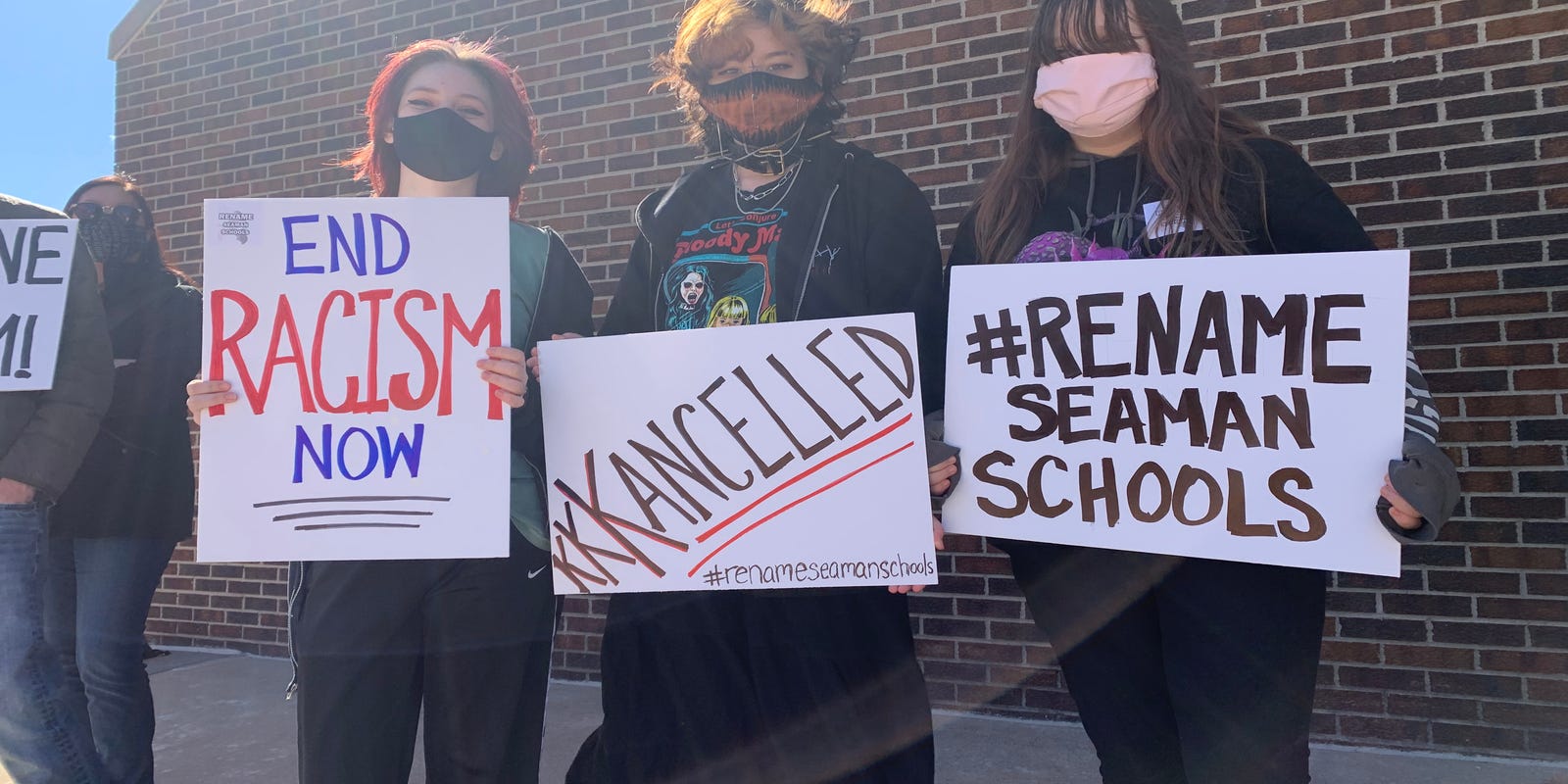Lifestyle
Discrimination has long been part of Seaman students’ experience. Here’s why they’re speaking out now.
Published
5 years agoon
By Matt Collins 
Editor

He found few friends by being himself.
“I was trying to prove myself instead of just being myself,” Patterson told The Capital-Journal. “I think it was basically my junior year when I decided I really just needed to be myself instead of trying to fit into a stereotype.”
Now a recent graduate from the high school, Patterson said he reflects back on what eventually became a lonely experience at Seaman, and on how most people’s perceptions of who he was supposed to be, came not from a place of malice, but one of ignorance.
And it’s a similar perception he sees when it comes to discussions of the district’s namesake, Fred Seaman, and his role as an exalted cyclops in the Ku Klux Klan.
Although rumors of Fred Seaman’s KKK connections were only recently confirmed, the underlying issues of race and discrimination have long persisted, if subtly, in the district, and students, emboldened by recent national movements on issues like Black Lives Matter, are now finding courage to speak out against not just the name, but the background issues, as well.
Kaya Pyle, a senior at Seaman who is one of the students leading the effort to rename the district, insisted that even though inclusion and equity are cornerstones of any modern school, issues like racism and discrimination are still “a huge deal in our schools, in our towns, in our community.”
“Students are still experiencing racism on a day-to-day basis and it’s essential that we can’t ignore that,” Pyle said. “We have to address it and we have to take care of it and do what’s right. We can’t encourage it or ignore the racism that is happening in our halls.”
Even if superficial, a change to the district’s name would speak volumes to a broader commitment to tackle discrimination and racism head on, said Anson Appelhanz, a junior at the school.
“I believe that the name change is productive for the district for the fact that it’s a great example of moving forward and definitely ridding ourselves of the culture that has clung to us for so long as a district, the racist culture, Fred Seaman,” Appelhanz said.
“I feel that this is just one step towards the eradication of that.”
Even without segregation, discrimination persisted in district’s history
By the high school yearbooks’ accounts, the schools in Seaman Unified School District 345 were never segregated, at least not like the neighboring Topeka USD 501.
By Kansas law that stood between 1879 and the 1954 Brown v. Board decision in the U.S. Supreme Court, school districts in the state’s cities of the first class (or above 10,000 residents) were allowed to create racially separated elementary schools, while smaller districts like Seaman were not allowed that same option.
No similar law existed to segregate the state’s high schools, although not as many high schools even existed in the early 20th century when only select groups of children were expected to complete their secondary education.
Early yearbooks in the Seaman school’s history show some, if proportionately few, Black students among the mostly white high school classes.
But even if the Seaman district’s schools, and other “integrated” districts in Kansas, didn’t practice discrimination by segregation, other evidence as recorded by the yearbooks shows discriminatory practices like minstrel shows and white students in blackface, as recently as the 1950s.
One collection of press clippings of the school’s minstrel shows even refers to the student group of actors as “Fred A. Seaman’s minstrel troupe,” perform various sketches while in blackface.
The troupe, described as having been composed of dozens of Seaman High boys and girls, is written as having “been coached especially for the production by Fred A. Seaman, principal of the Seaman rural high school. Real juggling, Negro melodies and many special numbers (were) on the program.”
And more recently, events like the 1991 Seaman Student Council’s “Slave Day,” in which students “purchased” other students as a fundraiser, have left a bitter legacy even if the events, back in their day, weren’t widely perceived with any racially ill intent.
The school community, though, did begin to realize how such events could be problematic, and the high school began offering a Race and Ethnic Studies course in the 1990s. Students that decade also organized a walkout from the high school in response to the fact that USD 345 was the only Shawnee County district not observing Martin Luther King Jr. Day.
Lately, though, Seaman High has committed itself to help address and eliminate racism in its schools’ community with the Equity Action Network, a student-focused group that includes teachers and administrators and has met weekly to determine how to build a more inclusive school community.
The Seaman district also planned a series of community conversations on race and inclusion, even before the pandemic. However, COVID-19 pre-empted the start of the series until after Fred Seaman’s connections to the KKK were revealed.
Students, and their lived experiences
Patterson, who transferred into the Seaman district from the more diverse Topeka USD 501, said like other students of color, most of the racism he experienced wasn’t anything overt, but more subtle microaggressions or misguided notions of who a Black student was supposed to be, at least from other students’ eyes.
Seaman USD 345, like most other school districts, has become increasingly diverse, with the percentage of students identifying as white dropping from upward of 90% in the 1990s to 80.5% this school year (comparatively, the more urban Topeka USD 501 reported 35.4% of its students were white this year).
Still, more than half of Seaman High’s students of color reported in a survey this year that they regularly experience racism, hearing racial slurs or passing jokes in the hallways.
In a sea of white faces, Patterson said he knew he stood out, and because of that, people ascribed to him expectations of how a Black student was supposed to behave from what they had seen in movies or on TV, as well as inherited assumptions from a school community that has traditionally been white.
“There were assumptions about me, that of course I’d do sports, or that of course I’d be jumping the highest or running the fastest,” he said. “But you can’t entirely blame a person when they haven’t been exposed to it themselves.”
Patterson, eager to fit in, found himself living out some of those stereotypes, but also challenging others’ ideas of what his role was supposed to be in the school society. He was going to do it all, becoming not only a star athlete but also a deeply involved student leader and figure in the high school.
It was also one of the loneliest places he could have been.
“When you’re putting on an act, you never really truly feel like you can be yourself,” he said. “When you see how people perceive you and want you to be, you shy away from it, and ask yourself if you’re not enough.”
Like other students across the nation, Patterson said he’s been inspired by social justice movements like Black Lives Matter to start living his life as a person of color more purposefully.
And it’s part of the reason why he sees and supports students in their recent drive to change the district’s name.
“The longer you push something down, the bigger it gets when it comes to light,” Patterson said. “I think that because we’re openly talking about things like this, things can finally start to get better.” Students, backed by teachers and alumni, push for change
After failing to see concrete actions from the Seaman Board of Education, a group of students took advantage of a snow day in February and launched a coordinated movement to pressure the district and board to take action on the name.
They argue that a district that prides itself on fostering, respecting and increasing diversity could not in good faith keep a name honoring a man with such a direct connection to the racist, white supremacist Ku Klux Klan.
Thousands of people have signed onto a petition by the student group urging the district to change its name, although it is unclear how many of the petitions’ 44,000 signatories actually live in the district, since the U.S. Census puts the district community at about 20,000 people. The petition’s platform, Change.org, also “boosted” the students’ petition, with signatories from all around the country signing.
In any case, with rumors of Fred Seaman’s KKK involvement now confirmed, alumni have joined in to ask the district to change its name, although the topic remains heavily divisive, at least on social media.
Joseph Randol, a third-generation Seaman alum from 2008, told The Capital-Journal that his time and experience in the district set him up for a successful career, but that the district’s name or legacy was largely irrelevant to that experience. Changing the name, he said, wouldn’t shortchange former or current students.
“The name is pretty irrelevant,” Randol said. “The fact that now, we know without a doubt that his actions and beliefs are more than just rumors — why would we want to hold onto that, and shame such a great community with a cloud of Fred Seaman’s name hanging over us?”
With rumors of Fred Seaman’s KKK connections lingering around the school in the decades since his death, alumni — like Amy Calhoun, the German teacher at Seaman High who herself graduated from the school in 2004 — had long known at least the implications of the district namesake’s connections.
But Calhoun, who plans on sending her children to the high school in the future, said she was proud of the student group for taking the moment’s inertia and bringing broader awareness to the issue of the district’s name.
“I think as a teacher that we get to have those connections that some other adults in the community may not have because we teach students that don’t look like us … I hope that the community can take a step back from where they are and understand that just because they haven’t been hurt — it doesn’t mean others haven’t,” Calhoun said.
And in pushing the movement to rename the Seaman district, students like Pyle say they’re speaking up for other students who may not be as comfortable voicing their concerns because of previous experiences as students of color in the district.
“I don’t feel like they have as strong a voice that they need and I want to be able to give them that voice that they need,” she said.
No definitive action Monday, but a platform for folks to ‘say what they want to say’
The Seaman Board of Education will revisit the topic of Fred Seaman’s KKK ties at its meeting Monday evening, after briefly addressing the issue and condemning racism and bigotry as having no place in the district at prior meetings.
Monday, however, will be the first substantive discussion on a potential name change, with the board set to consider a plan that would create a district task force — presumably made up of teachers, parents, students, alumni and administrators — to review the “complex” issue and examine the district’s options going forward.
“All voices are important in this discussion and we need to listen to understand each others’ viewpoints and perspectives,” board president James Adams wrote to the school community earlier in March. “We must remain sensitive to our current students, current families, alumni, businesses, organizations and all future school community members in finding a resolution. During this work, we remain committed to our effort in equity and creating an inclusive environment for all students.”
Adams told The Capital-Journal that he recognizes how the issue might be contentious among the school community, but he emphasized that the board has not had a real chance to even discuss a potential name change, especially since its past few monthly meetings have been held remotely.
Monday’s conversation, then, will mostly be about setting up logistics and expectations of what such a conversation will look like, and how to best allow the community to voice their opinions and perspectives on the topic in a civilized fashion, Adams said.
“I think that a lot of people are worried that something is going to happen overnight and they won’t have the chance to say what they want to say,” Adams said. “But my hope is that we’re providing a platform, and that we’ll unveil what we think a good approach will be to engage the entire community to be able to be heard, and say what they need to say about the issue.”
As always, the public will have a chance to speak at the board’s public comment period toward the beginning of the meeting, the board president said, and the 6 p.m. meeting is being moved to the high school’s gym to accommodate expected interest in the topic. The student group also has plans to protest outside the meeting.
Ever since Kansas’ school districts were reorganized under a numbered system in the 1960s, no readily available evidence shows if any other district has ever undertaken the process of changing its name, and the districts’ Unified School District numbers are what count legally.
Adams said the board recognizes the Fred Seaman question might just be part of a larger, national conversation schools are undertaking in discussing the legacy and relevance of mascots and schools named after controversial historical figures.
“It’s here now, and it’s our turn now to go through it,” he said.
But Adams said that no matter what comes of the conversations, he saw a chance for the district to be a model on how to hold those conversations.
Patterson, the recently graduated student, said he’s encouraged by his former classmates’ efforts to get the district’s name changed as part of a broader attempt to address lingering racial attitudes and perceptions that exist among the school community.
Doing so will only help USD 345 improve and move forward, he said, sharing a phrase his father often uses with him to help him reflect on himself and fix any flaws.
“I can think I’m hot stuff with ketchup on my shirt, but until someone points out I have ketchup on my shirt, I’m not going to know any better,” Patterson said. “Now, I think we’re pointing out that Seaman has ketchup on its shirt, and we’re starting to turn things around.”




